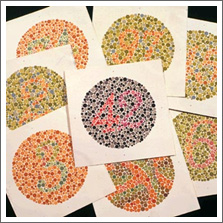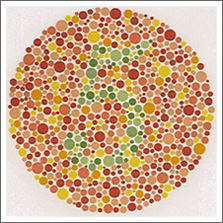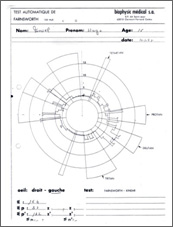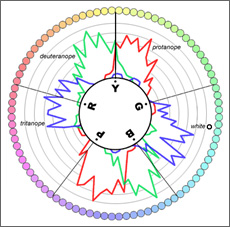
Diagnosis
Most of the times the diagnosis of daltonism is difficult. In many cases, it is unnoticed because the defect is only slight.
In severe cases – black and white vision – with nystagmus, on the contrary, the evidences of this defect appear quite early.
The most common form of daltonism is diagnosed through chromatic vision tests, of which the Ishihara’s Test and the Farnsworth’s 100 Hue Test are the most known. The Nagel’s Anomaloscope and the Holmgreen’s Wool Test are also used. More recently, other tests more sophisticated are employed, with the aid of computers and software specifically developed for studying the vision of colours, but they are only available in specialized centres.
The most used is the Ishihara’s Test, also known as pseudo isochromatic boards test: it consists in a sequence of cards with a miscellaneous background, composed of multiple chromatic tonalities, which include a number easily recognized by a normal person but not perceived by a colour-blind individual (Picture 4).
 |
 |
Picture 4: Examples of Ishihara cards.
The Farnsworth’s 100 Hue Test is also very used by ophthalmologists, but it is more difficult to apply and requires more cooperation. It consists in a series of coloured “discs” (Picture 5) with intermediate tonalities, which should be placed in correct sequence by the person carrying out the test. The results are presented in a diagram (Picture 6).
|
|
Picture 5: Farnsworth 100 Hue Test.
 |
 |
Picture 6: Graphic representation of chromatic defects with Farnsworth 100 Hue Test.
Treatment
that daltonism is not really a disease but just a different way of seeing colours.
Nowadays, there are lenses that increase the contrast between colours. ColorMax lenses were developed to improve the discrimination of colours that seem identical, and they can help patients with difficulties in distinguishing green from red.
Final observations
Except for severe cases of blindness, very rare, caused by the absence of all the cones, the prognosis is good. The disease is an alteration not progressive during lifetime, and most of the times it scarcely affects the patients’ life.
One of the difficulties of colour-blind individuals might be to recognize the colours of traffic lights, very important for safe driving. In general, the position of these signals allows any person to know which colour is lighted. In some cities, traffic lights are adapted for colour-blind drivers, with a white strip light beside the yellow light, thus differentiating the colour lighted below or above this luminous mark. The problem of railway traffic signals is not so simple, because their colours are inverted, sometimes generating confusion at level crossings. To avoid accidents, colour-blind persons should be aware of this fact.
Curiously, in specific situations, colour-blind individuals can even have some advantages over normal persons. Because their night vision can be better than that of a normal person, in situations of war, colour-blind individuals sometimes distinguish more easily camouflages concealed in the woods. This capacity was used in the Vietnam War and the Second World War to detect enemies during combat.
Nowadays a new problem has arisen for colour-blind persons from the use of Internet.
In fact, some sites have chromatic characteristics that create them visualizing difficulties.
Finally, a reference should be made to very rare cases of non-genetic chromatic defects, which may appear only during adolescence or adulthood, due to the use of certain drugs such as chloroquine, ethyl and methyl alcohol, and argon laser treatments. Unlike daltonism, these situations may become more severe with time if their cause is not eliminated.
| back |


